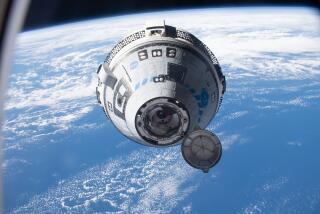Countdown Begins for Shuttle Flight : Space: The liftoff Tuesday will mark the final launching of the year. Atlantis astronauts are to deploy a missile-warning satellite.
- Share via
KENNEDY SPACE CENTER, Fla. — NASA started the countdown Sunday for the last space shuttle launching of the year, a nighttime ride into orbit by Atlantis with six astronauts and a military surveillance satellite on board.
Liftoff is scheduled for 3:51 p.m. PST Tuesday. It will be the seventh shuttle launching in darkness; the last one was a year ago.
NASA test director Eric Redding said the launch team found no problems. “Everything looks squeaky clean, and we hope it continues that way,” he said.
Weather forecasters predicted a 50-50 chance of favorable conditions at launch time. The main threat was rain, but the outlook was improving, shuttle weather forecaster Ed Priselac said.
“If we were to get showers in the area, they would probably be short-lived,” Priselac said.
Technicians today were to fill three battery-like fuel cells that will generate electricity aboard Atlantis. The shuttle itself will be fueled with 528,000 gallons of liquid hydrogen and liquid oxygen about nine hours before launch.
Mission commander Frederick Gregory and his crew are to release the $300-million missile-warning satellite from Atlantis six hours after liftoff. An attached rocket will later boost the satellite to a 22,300-mile-high orbit.
It is the first time the Pentagon has provided details to the public about the launching of a Defense Support Program satellite. The military has been sending up satellites on unmanned rockets for 20 years to detect nuclear detonations and space and missile launches.
Defense Department officials declassified the Atlantis flight about 18 months ago to save money. All but one of the eight previous military shuttle missions were conducted with secrecy.
While some details remain secret, such as the satellite’s destination, declassifying its ride on the shuttle has simplified work for program managers.
“It’s just made for a better camaraderie between us and NASA, and among the payload team, because we’re able now to talk about it in the open,” said Lt. Col. John Traxler, an Air Force test director.
Most of the astronauts’ other chores during the 10-day flight--radiation monitoring and medical tests--will be conducted publicly. The exceptions are two experiments in which the crew will use a telescope, cameras and binoculars to observe U.S. military installations around the world.
Military officials want to see how well astronauts can discern tanks, ships, planes and other craft 224 miles above Earth, in case such efforts are ever needed. Story Musgrave, a physician, was a crew member on that flight and will fly again this time. It is his fourth trip into space and midway through the mission he will set a record for shuttle flying time.
The long voyage--shuttle flight No. 6 for 1991--will give Musgrave a total of about 666 hours in space.
More to Read
Sign up for Essential California
The most important California stories and recommendations in your inbox every morning.
You may occasionally receive promotional content from the Los Angeles Times.










